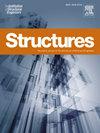基于剪力的简单支撑结构桥梁称重运动方法
IF 3.9
2区 工程技术
Q1 ENGINEERING, CIVIL
引用次数: 0
摘要
本文介绍了一种基于剪力的简支撑结构桥梁称重(B-WIM)方法。这种方法不使用玫瑰花形传感器进行剪切应变计算,而是通过在横截面中部靠近支座处倾斜 45° 放置的应变片测量应变得出剪切数据。这种传感器设置方式与花环配置方式相比,一个显著的实际优势是每根大梁只需一个应变片即可获取必要的现场数据。我们对这种传感器布置的理论基础及其与 B-WIM 方法的整合进行了详细说明。为了评估所建议方法的有效性,使用数值数据将其性能与等效弯曲 B-WIM 方法进行了比较。然后,为了在实践中评估所提出的方法,对巴西的一座简单支撑预应力混凝土桥梁安装了仪器,以收集基于跨中轴向应变的弯曲数据和支座附近的剪切数据。结果表明,采用基于剪切力的方法可大幅降低轴重估算的平均绝对误差,同时减少误差标准偏差,无论是在数值还是实际 B-WIM 数据中都是如此。这些发现证明了所提出的基于剪切力的 B-WIM 方法在改进道路桥梁轴重估算方面的功效,同时还能保持对车辆总重的准确预测。此外,这项研究也是文献中首次证明在 B-WIM 应用中使用剪切数据比弯曲数据更有优势。本文章由计算机程序翻译,如有差异,请以英文原文为准。
A shear-force-based Bridge Weigh-in Motion approach for simple supported structures
This paper introduces a shear-force-based Bridge Weigh-In-Motion (B-WIM) approach for simply supported structures. Instead of using rosette sensors for shear strain calculation, this method derives shear data from strain measurements taken with strain gauges positioned at the middle of the cross-section, inclined at 45°, near the support. A significant practical advantage of this sensor setup over the rosette configuration is that it requires only one strain gauge per girder to capture the necessary field data. The theoretical basis of this sensor arrangement and its integration into the B-WIM method are thoroughly explained. To evaluate the effectiveness of the proposed approach, its performance is compared to an equivalent bending B-WIM approach using numerical data. Then, in order to assess the proposed approach in practice, a Brazilian simply supported prestressed concrete bridge was instrumented to gather both bending data, based on axial strain in the middle of the span, and shear data near the supports. The results showed that the utilization of the shear based approach provided a substantial reduction in the mean absolute error in axle weight estimation, along with a decrease in the error standard deviation, both in numerical and in real-world B-WIM data. These findings demonstrate the efficacy of the proposed shear based B-WIM approach in improving axle weight estimation for road bridges, while also maintaining accurate predictions for gross vehicle weight. Furthermore, this study is the first in the literature to demonstrate the advantages of using shear data over bending data for B-WIM applications.
求助全文
通过发布文献求助,成功后即可免费获取论文全文。
去求助
来源期刊

Structures
Engineering-Architecture
CiteScore
5.70
自引率
17.10%
发文量
1187
期刊介绍:
Structures aims to publish internationally-leading research across the full breadth of structural engineering. Papers for Structures are particularly welcome in which high-quality research will benefit from wide readership of academics and practitioners such that not only high citation rates but also tangible industrial-related pathways to impact are achieved.
 求助内容:
求助内容: 应助结果提醒方式:
应助结果提醒方式:


